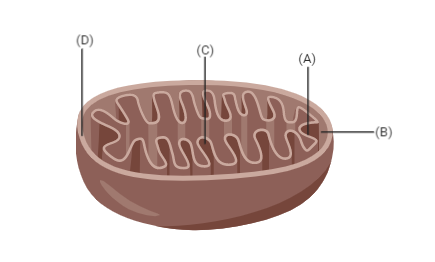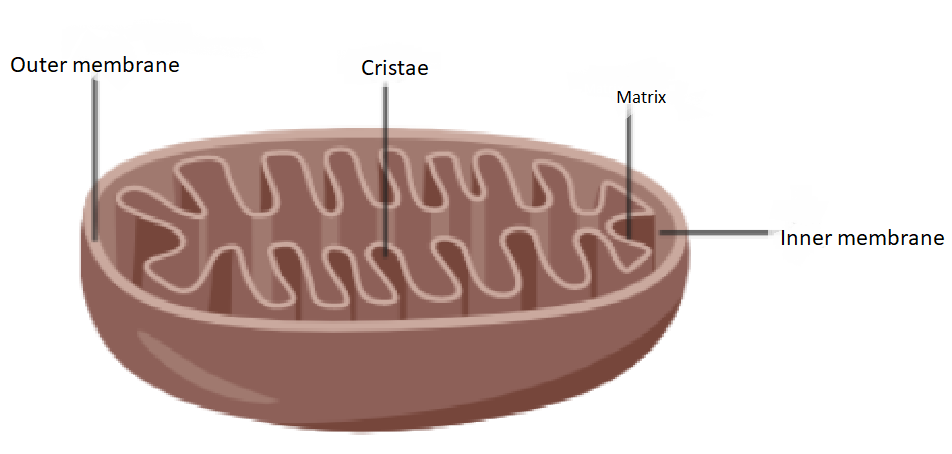
The figure above shows the structure of mitochondria with its four parts labeled (A), (B), (C), and (D). Select the part correctly matched with its function.

(I) Part (D): Outer membrane - gives rise to the inner membrane by splitting.
(II) Part (B): Inner membrane - forms infoldings called cristae.
(III) Part (C): Cristae - possess single circular DNA molecule and ribosomes.
(IV) Part (A): Matrix - a major site for respiratory chain enzymes.

Answer
555.3k+ views
Hint: The mitochondria are double membranous organelles that generate most energy for the cell’s biochemical reaction through ATP synthesis. They synthesize ATP which is said to be the currency of the cell.
Complete answer: Mitochondrion is that the semi-autonomous organelle has its own DNA and protein-synthesizing machinery. They can undergo fission and are not dependent on the nucleus to duplicate. The mitochondrial polymer has many exceptions to the universal ordering. Each mitochondrion has a double membrane where the outer membrane and also the inner membrane divides its lumen clearly into two binary compound compartments. It is the site of aerobic respiration. It produces cellular energy within the adenosine triphosphate, thus referred to as a 'powerhouse' of the cell.

-The outer membrane (D) is continuous and the protein-to-phospholipids ratio exists in 1:1 and contains integral membrane proteins known as porins and import proteins.
-The inner membrane (B) folds to create finger-like projections referred to as cristae toward the matrix. These are to increase the surface area. The folding of the inner membrane will increase the area within the cell organ, the accumulated area creating more room for reactions to occur. The fluid contained within the mitochondria is termed the matrix. It’s the house enveloped by the inner membrane. It’s necessary within the production of ATP with the help of the ATP synthase contained within the inner membrane.
-The inner membrane of mitochondria folds inward into a finger-like projection called cristae. It will increase the extent of absorption. Enzymes are the macromolecule molecules within the cells in the matrix that act because of the catalysts. Enzymes speed up chemical reactions within the body however don't get dried-up within the method. Most organic chemistry reactions in living things want enzymes.
Thus, option (II) is the correct answer.
Note: Embedded in this bilayer in the inner layer of mitochondria are various proteins that serve to carry out various functions in the electron transport chain. Also, the matrix acts as a site for ATP synthesis and the location of Krebs’s cycle.
Complete answer: Mitochondrion is that the semi-autonomous organelle has its own DNA and protein-synthesizing machinery. They can undergo fission and are not dependent on the nucleus to duplicate. The mitochondrial polymer has many exceptions to the universal ordering. Each mitochondrion has a double membrane where the outer membrane and also the inner membrane divides its lumen clearly into two binary compound compartments. It is the site of aerobic respiration. It produces cellular energy within the adenosine triphosphate, thus referred to as a 'powerhouse' of the cell.

-The outer membrane (D) is continuous and the protein-to-phospholipids ratio exists in 1:1 and contains integral membrane proteins known as porins and import proteins.
-The inner membrane (B) folds to create finger-like projections referred to as cristae toward the matrix. These are to increase the surface area. The folding of the inner membrane will increase the area within the cell organ, the accumulated area creating more room for reactions to occur. The fluid contained within the mitochondria is termed the matrix. It’s the house enveloped by the inner membrane. It’s necessary within the production of ATP with the help of the ATP synthase contained within the inner membrane.
-The inner membrane of mitochondria folds inward into a finger-like projection called cristae. It will increase the extent of absorption. Enzymes are the macromolecule molecules within the cells in the matrix that act because of the catalysts. Enzymes speed up chemical reactions within the body however don't get dried-up within the method. Most organic chemistry reactions in living things want enzymes.
Thus, option (II) is the correct answer.
Note: Embedded in this bilayer in the inner layer of mitochondria are various proteins that serve to carry out various functions in the electron transport chain. Also, the matrix acts as a site for ATP synthesis and the location of Krebs’s cycle.
Recently Updated Pages
Master Class 11 Economics: Engaging Questions & Answers for Success

Master Class 11 English: Engaging Questions & Answers for Success

Master Class 11 Social Science: Engaging Questions & Answers for Success

Master Class 11 Biology: Engaging Questions & Answers for Success

Class 11 Question and Answer - Your Ultimate Solutions Guide

Master Class 11 Business Studies: Engaging Questions & Answers for Success

Trending doubts
10 examples of friction in our daily life

One Metric ton is equal to kg A 10000 B 1000 C 100 class 11 physics CBSE

Difference Between Prokaryotic Cells and Eukaryotic Cells

1 Quintal is equal to a 110 kg b 10 kg c 100kg d 1000 class 11 physics CBSE

Explain zero factorial class 11 maths CBSE

What is a periderm How does periderm formation take class 11 biology CBSE




